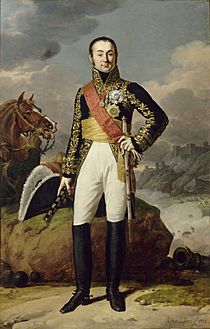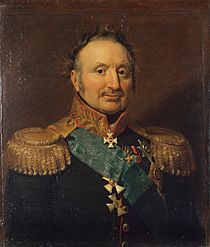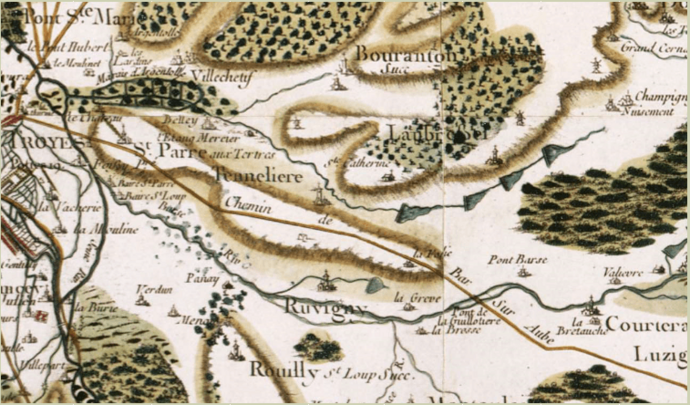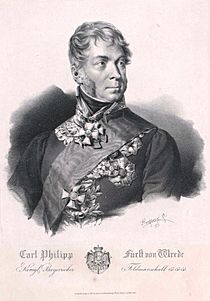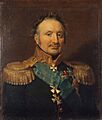Battle of Laubressel facts for kids
Quick facts for kids Battle of Laubressel |
|||||||
|---|---|---|---|---|---|---|---|
| Part of the Campaign of France of the Sixth Coalition | |||||||
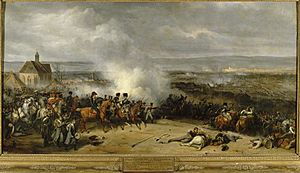 The battle of Laubressel, near Troyes |
|||||||
|
|||||||
| Belligerents | |||||||
| Commanders and leaders | |||||||
| Strength | |||||||
| 20,000 | 32,000-50,000 | ||||||
| Casualties and losses | |||||||
| 3,000 killed, wounded, or captured 7–11 guns lost |
1,000–1,500 killed, wounded, or captured | ||||||
The Battle of Laubressel happened on March 3, 1814. It was a fight during the War of the Sixth Coalition, where many European countries teamed up against Napoleon's France. In this battle, a large Allied army, led by Karl Philipp, Prince of Schwarzenberg, attacked the smaller French army. The French forces were commanded by Jacques MacDonald and Nicolas Oudinot.
The Allies attacked from three different directions. The French, especially those under Marshal Oudinot, fought hard. However, the Allies managed to push back the French left side. Because of this defeat, the French had to leave the city of Troyes and move west. The village of Laubressel is about 10 kilometers (6 miles) east of Troyes.
After the French won the Battle of Montereau on February 18, the Allied army moved back behind the Aube River. When Napoleon went north to fight another Allied army, he left MacDonald and Oudinot to watch Schwarzenberg's army. The Allies then defeated Oudinot at the Battle of Bar-sur-Aube. They kept pushing the French back towards Troyes. At Laubressel, the Allies were too strong for Oudinot's left side. The Allies slowly chased MacDonald's army all the way to Provins. Their advance stopped when they heard that Napoleon had won another battle.
Contents
Background: The War Continues
French Army on the Move
On February 18, 1814, Napoleon won a battle at Montereau. After this, the Austrian general Karl Philipp, Prince of Schwarzenberg ordered his army to retreat to Troyes. Schwarzenberg also asked his ally, Gebhard Leberecht von Blücher, for help. Blücher quickly moved his troops to Méry-sur-Seine to protect the Allies' northern side.
Schwarzenberg wanted to fight a big battle near Troyes on February 21–22. But he got bad news from his commander in the south. Marshal Pierre Augereau was threatening to take back Chalon-sur-Saône. Also, another French general was threatening Geneva. So, Schwarzenberg had to send some of his troops south to help.
Near Troyes, Schwarzenberg had about 90,000 soldiers, and Blücher had 50,000. Napoleon had about 75,000. Even though the Allies had more soldiers, Schwarzenberg's spies always thought Napoleon had more. The Allied soldiers were also tired and didn't have enough food. On February 22, the French tested the Allied defenses. Marshal Nicolas Oudinot's soldiers managed to cross the river at Méry. But they couldn't hold their position against the Allied counterattacks.
That night, Schwarzenberg decided to pull his army back behind the Seine River. Blücher was unhappy that Schwarzenberg didn't want to fight. He asked for permission to act on his own. Blücher planned to meet up with more Allied troops and then march towards Paris.
Meanwhile, on February 23, Schwarzenberg's army continued to retreat east. The Bavarian general Karl Philipp von Wrede led the rearguard, protecting the main army. The Allies tried to make a truce with Napoleon, but Napoleon's demands were too high. Near Troyes, French cavalry fought with Austrian cavalry. The Austrians lost many men and some companies were captured.
As the Allies retreated, Napoleon sent his troops to follow them. On February 26, Oudinot's troops took Bar-sur-Aube. MacDonald moved to Mussy-sur-Seine. The next morning, Napoleon finally learned that Blücher's army was heading for Paris. Blücher had a three-day head start.
Allies Fight Back
Napoleon ordered MacDonald to take charge of 42,000 soldiers. Their job was to defend against Schwarzenberg's army behind the Aube River. MacDonald had several army corps and cavalry units. Napoleon then took 35,000 troops and marched northeast to attack Blücher from behind. The French tried to hide the fact that Napoleon was no longer facing Schwarzenberg.
The Austrian commander, Schwarzenberg, quickly realized Napoleon was gone. On February 27, Schwarzenberg defeated Oudinot at the Battle of Bar-sur-Aube. Oudinot had placed his troops in a bad spot. Even though he had slightly more soldiers, much of his artillery and cavalry were on the other side of the river. He only fought with 18,000 troops and lost many men.
The day after his defeat, Oudinot pulled his troops back to Vendœuvres. The Allies followed slowly. MacDonald, who didn't know about Oudinot's loss, advanced to Laferté-sur-Aube. The Allies had destroyed the bridge there. On February 28, Allied soldiers attacked a French division at Silvarouvres and took the bridge. MacDonald then retreated to Bar-sur-Seine. Both sides lost about 600 men.
On March 1, the Allies sent out two scouting groups. One group, led by Johann Maria Philipp Frimont, occupied Vendœuvres after some small fights. The other group, led by Peter Petrovich Pahlen, moved to Frimont's right.
Feeling more confident, Schwarzenberg ordered his army to advance on Troyes for March 2. That day, Pahlen's troops found French soldiers holding the Guillotière Bridge. Pahlen moved north to reach Dosches. His attempts to push towards Laubressel were stopped by the French. Peter von Wittgenstein's Russian corps took Piney. Wrede's Bavarian-Austrian corps stayed near Vendœuvres. On the southern side, the Crown Prince of Württemberg and Gyulai chased MacDonald's forces. They pushed a French division out of Bar-sur-Seine, costing the Allies 500 men and the French 100.
The Battle of Laubressel
On March 3, at 1:00 pm, Schwarzenberg planned a big attack from three sides. He ordered Wrede's corps to attack west towards Troyes and take the Courteranges Woods. Wittgenstein was told to move southwest from Piney and meet Wrede's forces near Laubressel. The Crown Prince of Württemberg and Gyulai were to push northwest from Bar-sur-Seine.
To defend, Oudinot ordered Guillaume Philibert Duhesme's division to protect the Guillotière Bridge. Henri Rottembourg's division was placed on the Laubressel plateau. Other French divisions connected these positions. Oudinot's VII Corps and François Etienne de Kellermann's VI Cavalry Corps were further northwest, guarding another bridge on the Seine. Closer by, Antoine-Louis Decrest de Saint-Germain's II Cavalry Corps was at Saint-Parres-aux-Tertres. MacDonald's XI Corps was near Saint-Parres-lès-Vaudes, southeast of Troyes. Also to the south was Édouard Jean Baptiste Milhaud's V Cavalry Corps.
In the morning, Wrede's corps advanced. Wittgenstein's infantry marched from Piney towards Laubressel. Pahlen's advance guard quickly met Rottembourg's French troops. Pahlen's infantry and some cavalry started fighting Rottembourg's soldiers. The rest of Pahlen's cavalry went north to try and get around the French left side. They reached the unguarded village of Thennelières behind the French lines. There, they attacked a weakly guarded artillery park. Saint-Germain's cavalry arrived and took back most of the park. But the Russian cavalry still managed to capture 200 prisoners. Saint-Germain pushed Pahlen's cavalry back. Kellermann's corps then moved up to replace Saint-Germain's cavalry.
At 3:00 pm, Wittgenstein launched a two-part attack. This happened after he heard Wrede's cannons firing at the French. On the right, Duke Eugen of Württemberg led the Russian II Infantry Corps towards Bouranton. On the left, Andrei Ivanovich Gorchakov led the I Infantry Corps against Laubressel. The attack was strong, with soldiers moving in columns and supported by many cannons. Eugen's 3rd Division easily took Bouranton. But when they moved towards Thennelière, Kellermann's cavalry counterattacked. Eugen's 4th Division had a hard time fighting their way up the hills of Laubressel. After reaching the top, they had to defend against attacks from Saint-Germain's cavalry. Rottembourg's French infantry only had six cannons and suffered heavy losses from the 32 Russian cannons.
Wrede sent Bavarian soldiers across the Barce River near Courteranges. They moved through the woods to connect with Wittgenstein's Russians. As the Russians pushed Rottembourg off the Laubressel plateau, Oudinot ordered a retreat. Gorchakov's advance had been slowed by 20 French cavalry groups. But then, the Russian Kaluga Regiment attacked without orders. With the King of Prussia watching, they quickly took the high ground. At the same time, a French brigade was hit by two Russian regiments from the front and two from the side. This brigade broke apart and ran away.
Seeing his side being surrounded, Étienne Maurice Gérard ordered a retreat. Jarry and Rottembourg combined their divisions and retreated in an orderly way after leaving Laubressel. Their retreat was protected by cavalry and artillery. Wrede chose this moment to directly attack the Guillotière Bridge with four Bavarian battalions. In the confusion, Duhesme missed the first retreat orders. He was almost surrounded when Gérard sent the orders again. Duhesme's troops fought their way back to Saint-Parres-aux-Tertres. They lost 400 men and two cannons. The Crown Prince of Württemberg did not attack, allowing Molitor's XI Corps and Milhaud's cavalry to retreat without problems.
Aftermath: Retreat and Pursuit
The French lost about 2,600 soldiers killed and wounded, and 460 were captured. They also lost 7 to 11 cannons. The Allies lost about 1,000 to 1,500 soldiers killed and wounded. MacDonald, who was sick, had only about 21,000 infantry and 4,000 cavalry. He was facing a much larger Allied army. He decided to retreat slowly so his supply wagons could keep up.
Schwarzenberg was worried that Napoleon might suddenly appear. So, he ordered Wittgenstein and Wrede to attack Troyes right away. Gérard held out on the east bank of the Seine until 11:00 am, then pulled back into Troyes. The Allies fought their way into the outer parts of the city but were stopped by the city walls. They brought up howitzers (large cannons) and started shelling Troyes. During a break in the shelling, the French soldiers inside the city quietly left and joined MacDonald's retreating army.
Oudinot did not think a strong rearguard was needed in La Chapelle-Saint-Luc. Because of this, the Bavarian cavalry suddenly appeared behind Kellermann's cavalry, causing them to panic. Luckily for the French, their infantry stayed strong even though the cavalry ran away. But 400 French prisoners were captured by the Allies.
After recovering from this, Wittgenstein and Wrede chased the French. The Crown Prince of Württemberg and Gyulai advanced towards Sens. Schwarzenberg himself stayed in Troyes until March 12. By March 16, the Allies had pushed MacDonald's army back to Provins. That day, Schwarzenberg learned about Napoleon's victory at the Battle of Reims. He also heard that the French had captured Châlons-sur-Marne. Because of this news, the Allied advance stopped.
Images for kids



